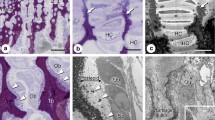Abstract.
To clarify the calcification mechanism that functions in bone formation in adult rats, the ultrastructure of tibial trabeculae and calvarial endostea obtained from 8- to 18-month-old rats was investigated morphologically, and compared with that of 19.5-day post-coitum fetal rats. In both samples, osteoid was observed between the activated osteoblasts and the calcified matrix, which contained matrix vesicles enclosed by a biological membrane. Some of these vesicles contained needle-like crystals thought to be hydroxyapatite, suggesting probable matrix vesicle calcification. These results indicate that matrix vesicle function not only in the initial calcification that occurs during embryonic ossification but also contribute to bone formation in adults.
Similar content being viewed by others
Author information
Authors and Affiliations
Additional information
Received: 16 September 1998 / Accepted: 3 January 2000
Rights and permissions
About this article
Cite this article
Hoshi, K., Ozawa, H. Matrix Vesicle Calcification in Bones of Adult Rats. Calcif Tissue Int 66, 430–434 (2000). https://doi.org/10.1007/s002230010087
Published:
Issue Date:
DOI: https://doi.org/10.1007/s002230010087




